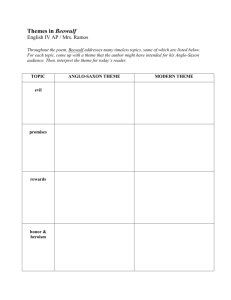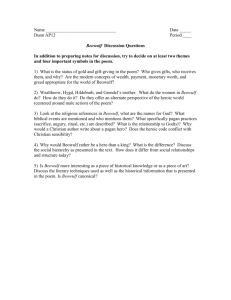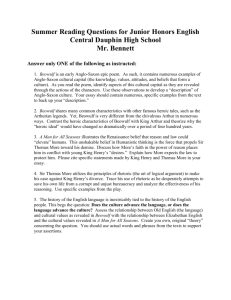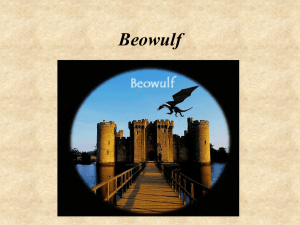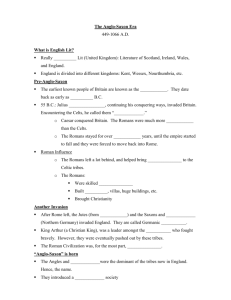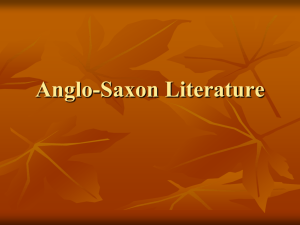the middle ages
advertisement
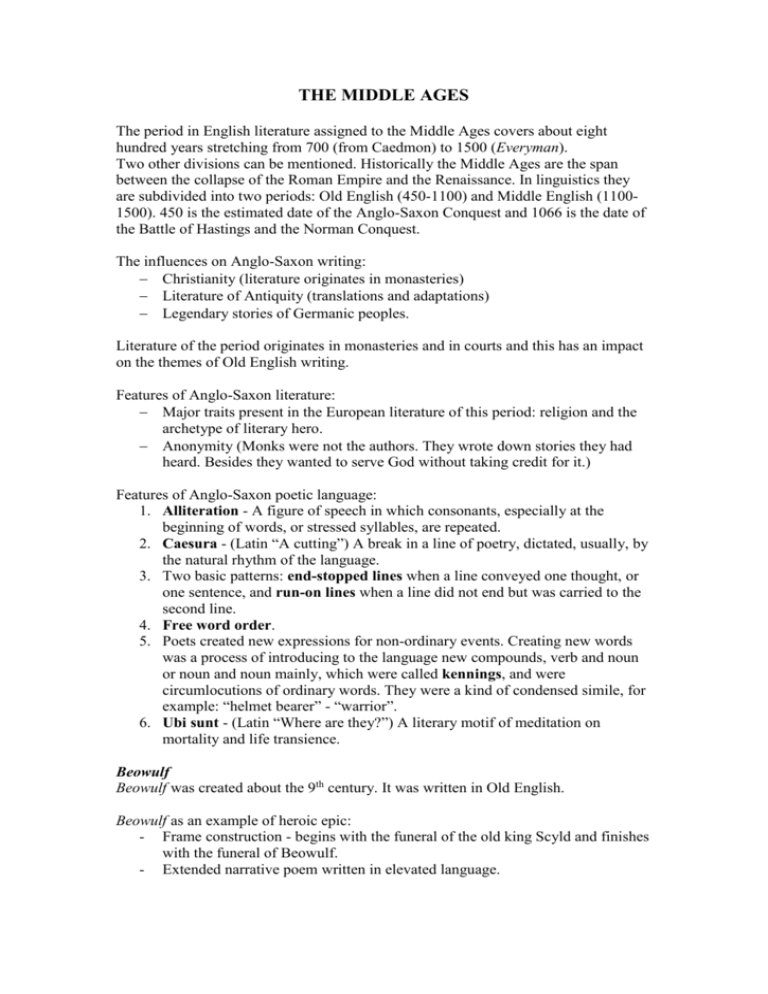
THE MIDDLE AGES The period in English literature assigned to the Middle Ages covers about eight hundred years stretching from 700 (from Caedmon) to 1500 (Everyman). Two other divisions can be mentioned. Historically the Middle Ages are the span between the collapse of the Roman Empire and the Renaissance. In linguistics they are subdivided into two periods: Old English (450-1100) and Middle English (11001500). 450 is the estimated date of the Anglo-Saxon Conquest and 1066 is the date of the Battle of Hastings and the Norman Conquest. The influences on Anglo-Saxon writing: Christianity (literature originates in monasteries) Literature of Antiquity (translations and adaptations) Legendary stories of Germanic peoples. Literature of the period originates in monasteries and in courts and this has an impact on the themes of Old English writing. Features of Anglo-Saxon literature: Major traits present in the European literature of this period: religion and the archetype of literary hero. Anonymity (Monks were not the authors. They wrote down stories they had heard. Besides they wanted to serve God without taking credit for it.) Features of Anglo-Saxon poetic language: 1. Alliteration - A figure of speech in which consonants, especially at the beginning of words, or stressed syllables, are repeated. 2. Caesura - (Latin “A cutting”) A break in a line of poetry, dictated, usually, by the natural rhythm of the language. 3. Two basic patterns: end-stopped lines when a line conveyed one thought, or one sentence, and run-on lines when a line did not end but was carried to the second line. 4. Free word order. 5. Poets created new expressions for non-ordinary events. Creating new words was a process of introducing to the language new compounds, verb and noun or noun and noun mainly, which were called kennings, and were circumlocutions of ordinary words. They were a kind of condensed simile, for example: “helmet bearer” - “warrior”. 6. Ubi sunt - (Latin “Where are they?”) A literary motif of meditation on mortality and life transience. Beowulf Beowulf was created about the 9th century. It was written in Old English. Beowulf as an example of heroic epic: - Frame construction - begins with the funeral of the old king Scyld and finishes with the funeral of Beowulf. - Extended narrative poem written in elevated language. - It celebrates the deeds of the hero and moments of great importance for the king and the nation. Two plans: human and supernatural. Detailed descriptions of duels and fights. Descriptions act as narration-retarding elements. Beowulf as an example of the Medieval hero: - Physically strong - Courageous - His destiny was to die in the battle. He had to know how to accept his fate. - He had social obligations towards his sovereign and fellow men. - Kinship relationships were very important. If anything happened to his family or king, he should take revenge. - The hero was male. Beowulf is an old pagan story told by a Christian poet. It means that even though the story has Anglo-Saxon origins, there are a few references to Christianity. For example, we know that Grendel and his mother belong to the race of monsters descended from Cain. When Beowulf is killed by the dragon, the poet can observe that his soul departs from the body, yet the hero’s funeral is a pagan one - he is burnt on a pyre. Old English poetry ELEGIES Old English poetry is also represented by a certain number of shorter poems of an elegiac nature (elegies). Elegy - a lament or poem of mourning. The term 'elegy' is sometimes used more loosely to describe any serious meditative poem. Characteristic features: the passage of time and the transience of earthly things, the pain of exile and separation, the ache of absence and longing, certain images and scenes such as ruined or abandoned buildings, desolate landscapes, storms at sea, darkness, night and the chill of winter. the final consolation is usually offered at the end of the poem. Most of the Old English elegies are monologues spoken by an unidentified character whose situation is unclear but who seems to be cut off from human society and the comforts of home and friendship. The Wanderer It is an elegy, written about the tenth century, telling of the hardships of a man who had known happiness and was respected in his lord’s court. Now the lord is dead and he had lost his post and became a wanderer who lives in despair. The topic of loyalty towards the lord is present in this poem. At the end the voice of wisdom gives him consolation saying that everything is transitory and that he will receive true joy only from Heavenly Father. The following are present in The Wanderer: ubi sunt, kennings, alliteration, caesura. RELIGIOUS POETRY Dream of the Rood It is one of the most important anonymous poems dating probably form the early eighth century. It falls into two parts. The poet describes his dream vision in which he saw the Holy Cross decorated with jewels and gold. As he looked at it, it became stained with blood. The Cross then starts speaking to him. It tells the story of the Crucifixion from the point of view of its own experience. It presents itself as a participant of the process of salvation. The wood demands equal respect with Christ not as the instrument of torture but as a participant in Christ’s sacrifice. There is a pagan element in The Dream of the Rood. It is an animistic idea of the speaking wood. The following techniques are used in the poem: Dream vision - the main character falls asleep and experiences events which have didactic of moral significance. Personification - attribution of human qualities to objects.

